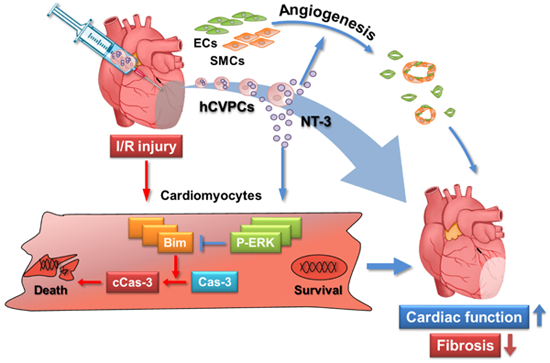Roles of Neurotrophin-3 in Cardiac Repair of Human Embryonic Stem Cell-Derived Cardiovascular Progenitor Cells
A recent study, led by Dr. YANG Huang-Tian from the Shanghai Institute of Nutrition and Health of the Chinese Academy of Sciences (CAS), reveals a new function of neurotrophin-3 (NT-3), a product of human embryonic stem cell-derived cardiovascular progenitor cells (hCVPCs) and hearts, against myocardial ischemia/reperfusion (I/R) injury and provides a potential therapeutic role of a non-cell approach for the treatment of ischemic heart disease.
Acute myocardial infarction (MI) resulting from coronary ischemia is a major cause of disability and death worldwide. Following MI, dead cardiomyocytes are replaced by fibrous scar tissue, causing ventricular remodeling and development of heart failure (HF). To rescue ischemic myocardium and limit infarct size timely and effective reperfusion in MI patients is the current therapeutic choice. However, this can cause additional damage, termed as I/R injury. Therefore, identifying ways to protect cardiomyocytes against I/R injury during the early stage of reperfusion and clarifying the underlying protective mechanisms are necessary to promote the development of new therapeutic approaches for the treatment of ischemic heart disease.
Previous study by Dr. YANG's team and collaborators demonstrated that transplantation of hCVPCs at the acute-phase of MI significantly improves the recovery of left ventricular function in the murine infarcted hearts and nonhuman primate MI models. The beneficial effects of hCVPCs to the infarcted hearts are associated with paracrine factors, such as hCVPC-secreted extracellular vesicles which promoting angiogenesis and inhibiting cardiomyocyte death.
YANG's team also identified hCVPC-secreted cytokines, including interleukin-4 and interleukin-13, modulate macrophage polarization toward a reparative phenotype in the infarcted hearts. However, it is unclear whether other proteins secreted from hCVPCs may exert synergistic cardioreparative effects, especially with respect to improving the cardiomyocyte survival during early reperfusion following myocardial ischemia.
Neurotrophins (NTs) are a family of highly conserved growth factors that serve a diverse set of functions in the nervous system and cardiovascular cells. NT-3, a member of the neurotrophin family and its functions in the adult hearts with myocardial I/R injury is unknown, meanwhile, whether NT-3 is a paracrine factor of hCVPCs to take part in regulation cardiac repair is unclear.
In this study, the researchers investigated protective effects of NT-3 secreted from hCVPCs in hearts against I/R injury. These beneficial effects were concomitant with reduced cardiomyocyte death, increased angiogenesis, and decreased scar formation. Moreover, endogenous NT-3 knockdown exacerbated myocardial I/R injury. Mechanistically, hCVPCs/NT-3 inhibited I/R-induced cardiomyocyte apoptosis through activating the extracellular signal-regulated kinase (ERK)-Bim signaling pathway to reduce activation of caspase-3, resulting in the cardioreparative effects of infarcted hearts together with their effects in the improvement of angiogenesis.
These results demonstrated that NT-3 is a novel endogenous cardioprotective factor and contributes to the hCVPC-mediated improvement of cardiac function and limitation of fibrosis formation. These findings provide novel insights into the role and mechanisms of the neurotrophin family member in the improvement of cardiomyocyte survival in I/R hearts, the paracrine action of hCVPCs in cell therapies for the ischemic heart disease, and the value of cell products in cell-free approaches for the treatment of ischemic heart disease.
The study entitled "Neurotrophin-3 contributes to benefits of human embryonic stem cell-derived cardiovascular progenitor cells against reperfused myocardial infarction" was published online in Stem Cell Transl Med on Feb. 2, 2021. Dr. YANG Huang-Tian is the corresponding author of the article. The graduate students BI Wei and Dr. WANG Jinxi are the co-first authors of this work. The work was collaborated with Prof. WANG Yigang’s team in University of Cincinnati Medical Center.
The research was funded by the National Key R&D Program of China, the Strategic Priority Research Program of CAS, the National Natural Science Foundation of China, etc.

The schematic diagram of the hCVPCs/NT-3 in myocardium repair after I/R.
(Image by Dr. YANG Huang-Tian’s research team)
Media Contact:
WANG Jin (Ms.)
Shanghai Institute of Nutrition and Health,
Chinese Academy of Sciences
Email: sibssc@sibs.ac.cn
Web: http://english.sinh.cas.cn/
